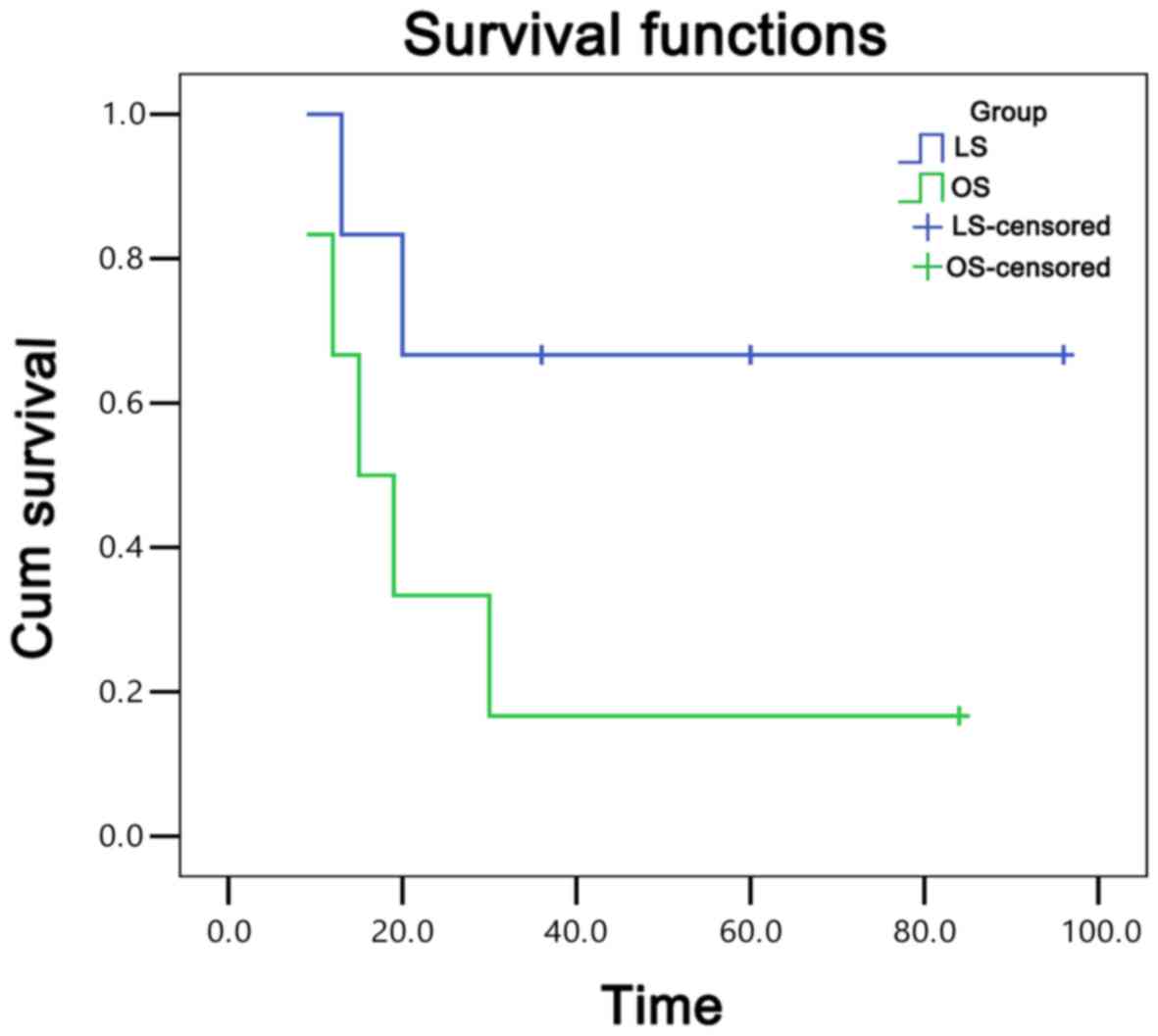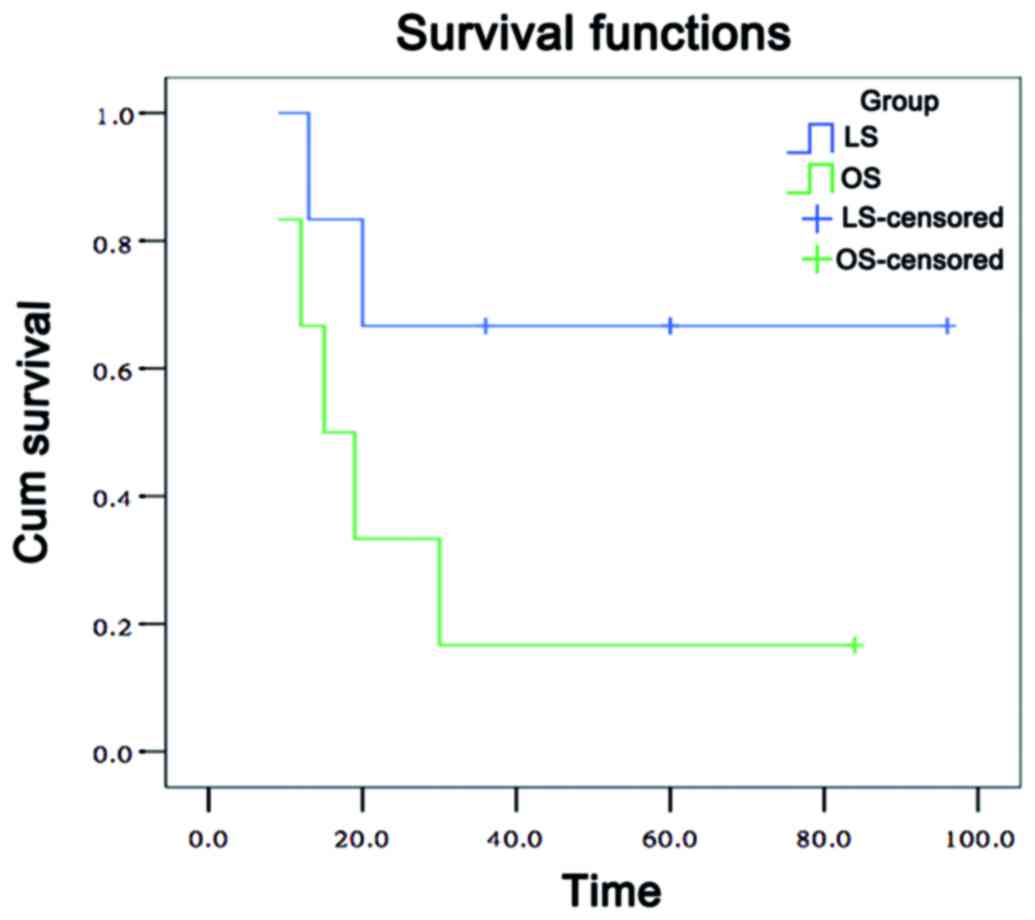|
1
|
Lai SQ, Ju FH and Wang GQ: The clinical
epidemiological characteristics of 704 cases of colorectal cancer
from 2004–2008. China Cancer. 19:111–113. 2010.
|
|
2
|
Zhou XY, Zhang JL and Wang ZK: Comparative
study of laparoscopic and open surgery for colorectal cancer:
Short-term results. J Laparosc Surg. 17:199–203
|
|
3
|
Wang SY and Chen ZY: Short-term outcomes
of laparoscopy surgery for colorectal cancer: A comparative study.
Fudan Univ J Med Sci. 37:92–99. 2010.
|
|
4
|
Pugliese R, DiLernia S, Sansonna F,
Ferrari GC, Maggioni D, Scandroglio I, Costanzi A, Magistro C and
De Carli S: Outcomes of laparoscopic Miles' operation in very-low
rectal adenocarcinoma. Analysis of 32 cases. Eur J Surg Oncol.
33:49–54. 2007. View Article : Google Scholar : PubMed/NCBI
|
|
5
|
Jacobs M, Verdeja JC and Goldstein HS:
Minimally invasive colon resection (laparoscopic colectomy). Surg
Laparosc Endosc. 1:144–150. 1991.PubMed/NCBI
|
|
6
|
Lezoche E, Feliciotti F, Paganini AM,
Guerrieri M, De Sanctis A and Campagnacci R: Laparoscopic colonic
resection. J Laparoendose Adv Surg Tech A. 11:401–408. 2004.
View Article : Google Scholar
|
|
7
|
Bipat S, Glas AS, Slors FJ, Zwinderman AH,
Bossuyt PM and Stoker J: Rectal cancer: Local staging and
assessment of lymph node involvement with endoluminal US, CT, and
MR imaging-a meta-analysis. Radiology. 232:773–783. 2004.
View Article : Google Scholar : PubMed/NCBI
|
|
8
|
Dural AC, Keskin M, Balik E, Akici M,
Kunduz E, Yamaner S, Asoglu Q, Gulluoglu M and Bugra D: The role of
the laparoscopy on circumferential resection margin positivity in
patients with rectal cancer: Long-term outcomes at a single
high-volume institution. Surg Laparosc Endosc Percutan Tech.
25:129–137. 2015. View Article : Google Scholar : PubMed/NCBI
|
|
9
|
Lujan J, Valero G, Hernandez Q, Sanchez A,
Frutos MD and Parrilla P: Randomized clinical trial comparing
laparoscopic and open surgery in patients with rectal cancer. Br J
Surg. 96:982–989. 2009. View
Article : Google Scholar : PubMed/NCBI
|
|
10
|
Keller DS, Champagne BJ, Reynolds HL Jr,
Stein SL and Delaney CP: Cost-effectiveness of laparoscopy in
rectal cancer. Dis Colon Rectum. 57:564–569. 2014. View Article : Google Scholar : PubMed/NCBI
|
|
11
|
Guillou PJ, Quirke P, Thorpe H, Walker J,
Jayne DG, Smith AM, Heath RM and Brown JM: MRC CLASICC trial group:
Short-term endpoints of conventional versus laparoscopic-assisted
surgery in patients with colorectal cancer (MRC CLASICC trial):
Multicentre, randomised controlled trial. Lancet. 365:1718–1726.
2005. View Article : Google Scholar : PubMed/NCBI
|
|
12
|
Kang SB, Park JW, Jeong SY, Nam BH, Choi
HS, Kim DW, Lim SB, Lee TG, Kim DY, Kim JS, et al: Open versus
laparoscopic surgery for mid or low rectal cancer after neoadjuvant
chemoradiotherapy (COREAN trial): Short-term outcomes of an
open-label randomised controlled trial. Lancet Oncol. 11:637–645.
2010. View Article : Google Scholar : PubMed/NCBI
|
|
13
|
Zhou ZG, Hu M, Li Y, Lei WZ, Yu YY, Cheng
Z, Li L, Shu Y and Wang TC: Laparoscopic versus open total
mesorectal excision with anal sphincter preservation for low rectal
cancer. Surg Endosc. 18:1211–1215. 2004. View Article : Google Scholar : PubMed/NCBI
|
|
14
|
Braga M, Frasson M, Vignali A, Zuliani W,
Capretti G and Di Carlo V: Laparoscopic resection in rectal cancer
patients: Outcome and cost-benefit analysis. Dis Colon Rectum.
50:464–471. 2007. View Article : Google Scholar : PubMed/NCBI
|
|
15
|
Pollett WG and Nicholls RJ: The
relationship between the extent of distal clearance and survival
and local recurrence rates after curative anterior resection for
carcinoma of the rectum. Ann Surg. 198:159–163. 1983. View Article : Google Scholar : PubMed/NCBI
|
|
16
|
Bernstein TE, Endreseth BH, Romundstad P
and Wibe A: Norwegian Colorectal Cancer Registry: What is a safe
distal resection margin in rectal cancer patients treated by low
anterior resection without preoperative radiotherapy? Colorectal
Dis. 14:e48–e55. 2012. View Article : Google Scholar : PubMed/NCBI
|
|
17
|
Fitzgerald TL, Brinkley J and Zervos EE:
Pushing the envelope beyond a centimeter in rectal cancer:
Oncologic implications of close, but negative margins. J Am Coll
Surg. 213:589–595. 2011. View Article : Google Scholar : PubMed/NCBI
|
|
18
|
Tan WS, Tang CL, Shi L and Eu KW:
Meta-analysis of defunctioning stomas in low anterior resection for
rectal cancer. Br J Surg. 96:462–472. 2009. View Article : Google Scholar : PubMed/NCBI
|
|
19
|
Huser N, Michalski CW, Erkan M, Schuster
T, Rosenberg R, Kleeff J and Friess H: Systematic review and
meta-analysis of the role of defunctioning stoma in low rectal
cancer surgery. Ann Surg. 248:52–60. 2008. View Article : Google Scholar : PubMed/NCBI
|
|
20
|
Kim JS, Cho SY, Min BS and Kim NK: Risk
factors for anastomotic leakage after laparoscopic intracorporeal
colorectal anastomosis with a double stapling technique. J Am Coll
Surg. 209:694–701. 2009. View Article : Google Scholar : PubMed/NCBI
|
|
21
|
Ito M, Sugito M, Kobayashi A, Nishizawa Y,
Tsunoda Y and Saito N: Relationship between multiple numbers of
stapler firings during rectal division and anastomotic leakage
after laparoscopic rectal resection. Int J Colorectal Dis.
23:703–707. 2008. View Article : Google Scholar : PubMed/NCBI
|
|
22
|
Park JS, Choi GS, Kim SH, Kim HR, Kim NK,
Lee KY, Kang SB, Kim JY, Lee KY, Kim BC, et al: Multicenter
analysis of risk factors for anastomotic leakage after laparoscopic
rectal cancer excision: The Korean laparoscopic colorectal surgery
study group. Ann Surg. 257:665–671. 2013. View Article : Google Scholar : PubMed/NCBI
|
|
23
|
Ng SS, Lee JF, Yiu RY, Li JC, Hon SS, Mak
TW, Leung WW and Leung KL: Long-term oncologic outcomes of
laparoscopic versus open surgery for rectal cancer: A pooled
analysis of 3 randomized controlled trials. Ann Surg. 259:139–147.
2014. View Article : Google Scholar : PubMed/NCBI
|
|
24
|
Jayne DG, Guillou PJ, Thorpe H, Quirke P,
Copeland J, Smith AM, Heath RM and Brown JM: UK MRC CLASICC Trial
Group: Randomized trial of laparoscopic-assisted resection of
colorectal carcinoma: 3-year results of the UK MRC CLASICC Trial
Group. J Clin Oncol. 25:3061–3068. 2007. View Article : Google Scholar : PubMed/NCBI
|
|
25
|
Laurent C, Leblanc F, Wütrich P, Scheffler
M and Rullier E: Laparoscopic versus open surgery for rectal
cancer: Long-term oncologic results. Ann Surg. 250:54–61. 2009.
View Article : Google Scholar : PubMed/NCBI
|
|
26
|
Yamamoto S, Ito M, Okuda J, Fujii S,
Yamaguchi S, Yoshimura K, Sugihara K and Watanabe M: Japan Society
of Laparoscopic Colorectal Surgery: Laparoscopic surgery for stage
0/I rectal carcinoma: Short-term outcomes of a single-arm phase II
trial. Ann Surg. 258:283–288. 2013. View Article : Google Scholar : PubMed/NCBI
|
|
27
|
Lacy AM, García-Valdecasas JC, Delgado S,
Castells A, Taurá P, Piqué JM and Visa J: Laparoscopy-assisted
colectomy versus open colectomy for treatment of non-metastatic
colon cancer: A randomised trial. Lancet. 359:2224–2229. 2002.
View Article : Google Scholar : PubMed/NCBI
|











